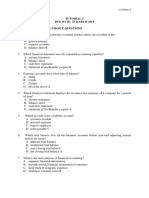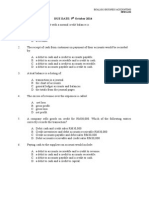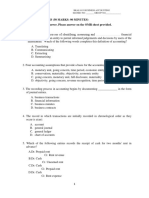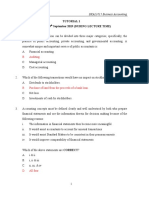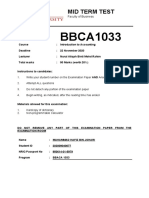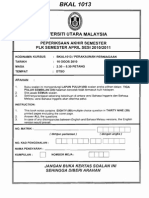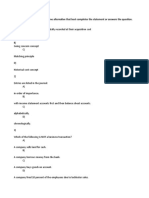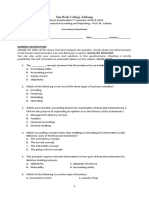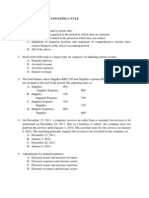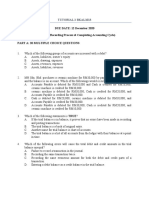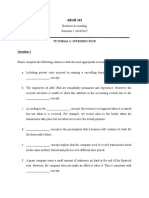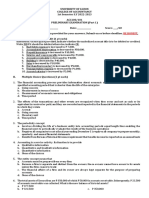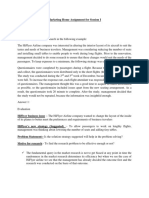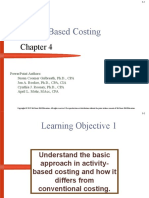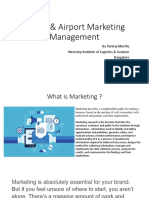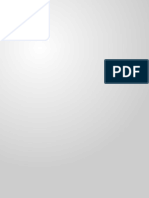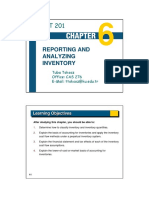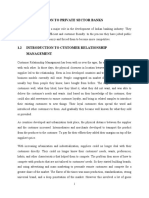BKAL1013 BUSINESS ACCOUNTING
A162
Part 1: MCQs
1. Which of the following statements is INCORRECT?
A. Accounting is a link between business activities and decision makers.
B. Management must have a good understanding of accounting to set financial
goals and make financial decisions.
C. Management only needs to understand how accounting information is
compiled and processed.
D. Accounting information is imperfect and should be interpreted with caution.
2. Financial Reporting Foundation (FRF) is differ from Malaysian Accounting Standards
Board (MASB) because:
A. it was established under the Financial Reporting Act 1997.
B. it has no direct responsibility with regard to standard setting.
C. it comprises representation from all relevant parties in the standard setting
process.
D. both are working together to make up the new framework for financial
reporting in Malaysia.
3. A public accountant probably would NOT:
A. advise on management issues.
B. audit financial information.
C. prepare tax returns.
D. prepare marketing analysis.
4. Which of the following groups use accounting information primarily to help protect
the public?
A. Management
B. Regulatory agencies
C. Taxing authorities
D. Economic planners
5. The characteristic of accounting information that can provides predictive and
feedback value is:
A. relevance.
B. reliability.
C. creativity.
D. comparability.
6. The accounting information is comparable when:
A. it is trusted by users.
B. it is helpful in contrasting organizations.
C. it is timely presented.
D. it affects the decision of its users.
1
� BKAL1013 BUSINESS ACCOUNTING
A162
7. The Statement of Profit or Loss and Other Comprehensive Income reports the
revenues and expenses for a period of time based on the:
A. historical cost.
B. matching principle.
C. objectively principle.
D. full disclosure.
8. The sources and uses of cash over a stated period of time are reflected on the:
A. profit and loss and other comprehensive income.
B. statement of owner’s equity.
C. statement of financial position (balance sheet).
D. statement of cash flows.
9. The accounting equation should remain in balance because every transaction affects:
A. only one account.
B. only two accounts.
C. two or more accounts.
D. none of the above.
10. The accounting principle that requires financial statement information to be based on
costs incurred in business transactions, and requires assets and services to be recorded
initially at the cash or cash-equivalent amount given in exchange, is the:
A. accounting equation principle.
B. historical cost principle.
C. going-concern principle.
D. business entity principle.
For question 11-17, please indicate the BEST effect of the transactions on the
accounting equation.
11. On 28 July 2016, Ms Dobi received cash of RM35,000 from the owner, Sally as
additional investment.
On 30 July 2016, a total cash of RM11,500 was used to pay the salary of the
employees and another RM5,000 was used to pay the bank loan. The changes caused
by these transactions may include:
A. Decrease in assets RM21,500; increase in owner’s equity RM35,000
B. Increase in assets RM35,000; decrease in liabilities RM10,000
C. Decrease in assets RM16,500, decrease in owner’s equity RM11,500
D. Increase in assets RM18,500; owner’s equity remains unchanged
2
� BKAL1013 BUSINESS ACCOUNTING
A162
12. On 10 September 2016, Hussein purchased office supplies for RM4,500, paid
RM1,000 and agreed with the supplier to pay the remaining in the following month.
A. Decrease in assets RM1,000; increase in owner’s equity RM3,500
B. Increase in assets RM3,500; increase in liabilities RM3,500
C. Decrease in assets RM4,500, owner’s equity remains unchanged
D. Increase in assets RM4,500; increase in owner’s equity RM4,500
13. A RM10,000 account payable is paid by the business. How is the accounting equation
affected?
A. Assets decrease RM10,000; owner's equity increases RM10,000
B. Assets decrease RM10,000; liabilities decrease RM10,000
C. Assets increase RM10,000; owner's equity decreases RM10,000
D. Assets increase RM10,000; liabilities increase RM10,000
14. A shop-house is purchased by a business for RM300,000. The company pays for the
shop-house with a RM60,000 cash payment and the execution of an RM240,000
promissory note payable to the seller. How does this purchase affect the business's
accounting equation?
A. Assets increase RM240,000; liabilities decrease RM60,000
B. Assets increase RM60,000; liabilities decrease RM240,000
C. Assets increase RM240,000; owner's equity increases RM240,000
D. Assets increase RM240,000; liabilities increase RM240,000
15. Jasmine Bakery started the year with total assets of RM120,000 and total liabilities of
RM60,000. During the year, the business earned revenues of RM180,000 and incurred
expenses of RM105,000. There is no capital contributions during the year, but the
owner make withdrawals of RM90,000. What is the amount of owner's equity at the
end of the year?
A. RM60,000
B. RM75,000
C. RM45,000
D. RM15,000
16. Equipment is purchased for cash. Which of the following is TRUE?
A. There is an increase in total assets
B. There is a decrease in both total assets and total liabilities
C. There is an increase in total assets and a decrease in total liabilities
D. There is no effect on total assets
17. A utility bill is received for expenses incurred. It will be paid in the following
accounting period. Which of the following would be TRUE as a result of the receipt
of the utility bill?
3
� BKAL1013 BUSINESS ACCOUNTING
A162
A. Net income will increase
B. Owner's equity will decrease
C. Total liabilities will decrease
D. There will be no effect on total liabilities
18. A company sells goods on credit for RM30,000. Which of the following entries
correctly records the transaction?
A. Debit cash and credit sales RM30,000
B. Credit inventories and debit accounts receivable RM30,000
C. Credit accounts payable and debit sales RM30,000
D. Debit accounts receivable and credit sales RM30,000
19. A company had a cash balance of RM30,000 on 1 August 2014. During August total
payments were RM384,000 and total receipts were RM357,000. What is the cash
book balance at 31 August 2014?
A. RM 1,800
B. RM 3,000
C. RM 4,500
D. RM 6,000
20. The recording of debit and credit parts of a transaction is:
A. checking equality.
B. double-entry accounting.
C. single-entry accounting.
D. transaction analysis.
Part 2: Structure Question
Refer text book-Rosli et al. (2011). PR 2-1, chapter 2, page 92.
“END OF QUESTION”
4
� BKAL1013 BUSINESS ACCOUNTING
A162
TUTORIAL # 1 DUE DATE: 12th March 2017
MATRIC NO: _____________ GROUP: _____
NAME: ______________________________________
ANSWER: Part 1
1. 11.
2. 12.
3. 13.
4. 14.
5. 15.
6. 16.
7. 17.
8. 18.
9. 19.
10. 20.




